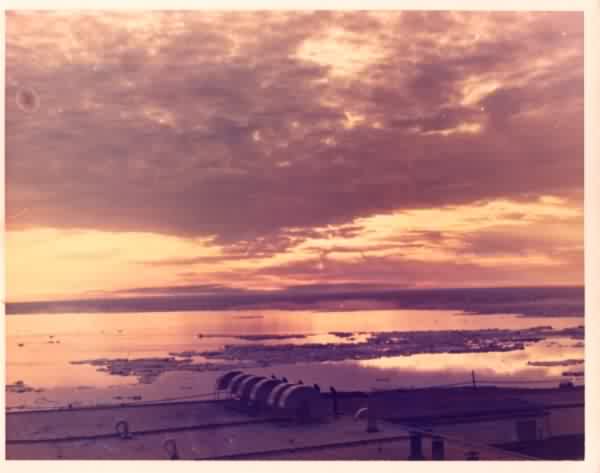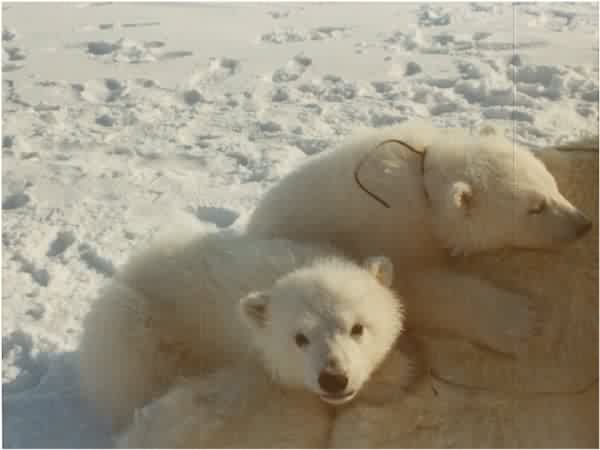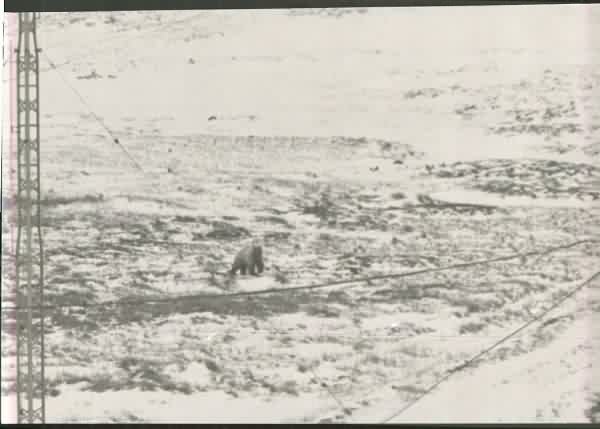1976 Photos & Notes
Contributed by Eugene R. Culp, LtCol USAF, ret.

Aerial view of Cape Liburne AFS taken during the summer of 1976. Note 5,000 ft. gravel surfaced
runway along water`s edge. Two orange tanks are fuel tanks and two white tanks across the road
are water storage tanks. Total water capacity was approximately 500,000 gallons with about 300,000 of that
amount dedicated to fire reserve. Water was pumped into the tanks from the bed of the stream
running perpendicular to the ocean at the bottom of the photo from the spring thaw in June through
the fall freeze in September. Water rationing was necessary most of 1976 because of equipment failures
in 1975 and 1976. One arctic shower was permitted per week. An arctic shower was one minute of
water to get wet, turn off the water and lather up and one minute of water to rinse. Also, the
dining hall and NCO Club used paper/plastic in place of china plates, etc. Only glasses and
silverware were washed.
AT the top center of the photo, the search radar and tropspheric scatter microwave antennae
can be seen. Beyond the far end of the runway an abandoned tramway is barely visible and beyond
that, and not visible, is a small cemetery of native Alaskans. The town of Wevok existed at this
location until 1931 when a smallpox epidemic decimated the town. The survivors left the area and
only the cemetery remains to documetn their presence at the site.

Photo of the Chukchi Sea taken from the main building`s second story weather observation tower
during the summer of 1976. Note the ice floes in the foreground and the solid line of ice in
the distance. As the sun never set from late May through late July, this picture was probably taken in
August. That autumn the Chukchi Sea froze from the shoreline to about a quarter mile out to sea
in ten hours.

No smog here! The moon shines brightlyover "Top Camp" at Cape Lisburne.

The site played host to many visitors, some human and some not. These polar bear cubs are
loosely tied to their mother on an ice floe not far from the site. She is tranquilized and
is becoming a statistic in a study to determine the migratory habits of polar bears. When she
recovers, the loose tether will pull away and the cubs and mom will go on their way. One polar bear,
recently weaned from its mother, decided to dine in the site dumpster rather than hunt seals
and had to be tranquilized by the Alaska Dept. of Fish and Game and hauled out to sea in a
sling hung from a helicopter. By 1976, hunting polar bears was illegal except by native
Alaskans. Looking through the site logs, it was interesting to note the number of general
officers who found it necessary in previous years to visit Cape Lisburne during polar bear
hunting season. Just a coincidence, don`t you think?
Polar bears have not natural enemies and figure anthing that moves is good eating. A second
polar bear which decided to take up residence at Cape Lisburne tried to take a bite out of the
tire of the Wein Airlines Twin Otter (the "Weenie Bird") as it taxied up to the site terminal.
That bear was shot by an Eskimo from Point Hope who happened to arrive at the site while the bear
was in the "courtyard" in the center of the compound. Ironically, the Alaska Dept. of Fish
and Game people were in Kotzebue awaiting a flight to Cape Lisburne to tranquilize and deport
the bear out to sea.

In the autumn of 1976, the caribou migrated inland rather than taking their normal route
along the coast. That change made the barren ground grizzly bears living nearour site very hungry
and our dining hall dumpster became their favorite bistro. Fortunately, our two site mascots, Huskies
named Nikki and Bad Ass would warn us of the bears` approach and an announcement over our PA
system would caution everyone to stay inside until the bears left.




